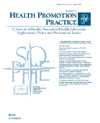Journal Articles on Program Successes: Communities in Action
This program is no longer funded. Learn more about current programs.
The following journal articles describe the research and success of local level changes brought about by communities participating in CDC's Healthy Communities Program:

Health Promotion Practice (Society for Public Health Education journal)
April 2009 special supplement – Fostering Healthy Communities: Lessons Learned from CDC's Premier Community-Based Interventions
Cultivating Healthy Communities: The CDC Perspective
Given the scope of chronic diseases in the U.S. population, community-based solutions are essential to effectively preventing chronic disease and to maintaining the best possible health among persons living with chronic illnesses. CDC finds at least four key ingredients that are essential to success in preventing chronic diseases and achieving health equity: 1) investing in communities, 2) providing a venue for communities to learn about effective strategies, particularly those related to policy, systems, and environmental changes, 3) mobilizing networks for change, and 4) providing communities with tools to assist them as they mobilize to achieve health equity and prevent chronic diseases.
Targeting the Taqueria: Implementing Healthy Food Options at Mexican American Restaurants (Steps to a Healthier Salinas, California)
Salinas Steps developed a taqueria intervention addressing obesity and diabetes among Mexican Americans. The initial response to the intervention has shown positive changes, which include the taqueria owners promoting available healthy menu items and modifying other menu offerings to reduce fats and increase fruit and vegetable availability. This, in turn, has led to a transition of the owners' perceptions of themselves as gatekeepers for a healthy community.
Rock on Cafe: Achieving Sustainable Systems Changes in School Lunch Programs (Steps to a Healthier New York)
Because roughly one third of a child's dietary intake occurs during school hours and because both health and academic outcomes have been linked to children's nutrition, school nutrition policies and programs have been identified as a key area for intervention. This article describes the components, processes, and initial successes of a grassroots effort and innovative project to improve the nutritional quality of the School Lunch Program through a sustainable systems intervention and policy change across a regional area of upstate New York.
Strategies for Implementing Health Promotion Programs in Multiple American Indian Communities (Steps to a Healthier Anishinaabe, Michigan)
American Indians experience significant health disparities compared to the general U.S. population. Steps to a Healthier Anishinaabe adopted a unique framework to implement health promotion intervention activities in multiple American Indian communities in Michigan by enabling each community to tailor interventions to their specific culture and health priorities. This article describes the community-based framework and argues that multisite, community-tailored health promotion programs are a promising approach to reducing health disparities in minority populations.
Evaluating Mobilization Strategies With Neighborhood and Faith Organizations to Reduce
Risk for Health Disparities (REACH: Kansas City, Missouri)
The Kansas City–Chronic Disease Coalition aimed to engage neighborhoods and faith organization in changing conditions to reduce risk for cardiovascular disease and diabetes. Using a time series design replicated with each of these two sectors, the effects of a microgrant strategy and a resource distribution strategy on the coalition's facilitation of community change were examined. Results indicate that both strategies increased the implementation of community change by neighborhood and faith organizations, with higher rates of change for the microgrant strategy.
Effective Strategies for Integrating Immunization Promotion Into Community Programs (REACH: New York City)
Most immunization coalitions have originated with health care providers, potentially excluding families without medical homes. This study focused on a community-based approach to providing timely vaccinations. A coalition of 23 organizations developed an immunization program in a low-income community in New York City. Nearly 1,000 community health workers incorporated immunization promotion into social service and educational programs. Immunization rate improvements maintained for a 5-year period, suggesting this approach to be sustainable.
From Making Pamphlets to Making Policies: Results From a Collaborative Training to Increase Knowledge, Motivation, and Self-Efficacy for Achieving Public Health Policy and Systems Change (Steps to a Healthier Washington)
Steps to a Healthier Washington implemented training to improve public health practice and create greater organizational and staff capacity for promoting effective policy and systems changes, including reducing disparities. The training is grounded in behavior change and adult learning theories. A comprehensive post-training evaluation found long-term improvements in self efficacy, reported changes in work, and attribution of those changes to the training. Organizations working to refocus public health work on policy and systems change should consider providing skills-based policy training to their staff.
A Community Response to the Food Environment (Pioneering Healthier Communities: West Michigan)
In 2005, Pioneering Healthier Communities created the Activate West Michigan coalition. One of its earliest objectives was to increase fruit and vegetable consumption for people who lived in low-income, African American, and Latino communities in urban Grand Rapids. Because the existing food environment created barriers to this objective, the coalition created community and schoolyard gardens and farmers' markets. By 2008, the Activate West Michigan coalition had begun to improve the food environment by establishing nine community and schoolyard gardens and five farmers' markets.
A Pebble in the Pond: The Ripple Effect of an Obesity Prevention Intervention Targeting the Child Care Environment (Steps to a Healthier Arizona)
This article describes the success of a program aimed at preventing childhood obesity and diabetes. Partners in Yuma County worked with child care providers to implement organizational best practices which promote positive nutrition and physical activity behaviors in young children. As a result of this project, the number of child care centers in Yuma County implementing best practices increased. Additionally a ripple effect has reached beyond the individual child care setting, into broader local and state early childhood development systems.

MMWR (CDC journal) – November 21, 2008 and September 24, 2010 issues
Prevalence of Selected Risk Behaviors and Chronic Diseases and Conditions—Steps Communities, United States, 2006–2007
Using a modified Behavioral Risk Factor Surveillance System (BRFSS) survey in 2006 and 2007, Steps communities, funded by CDC's Healthy Communities Program, collected data related to the three diseases and outcomes (obesity, diabetes, and asthma), and the three related risk factors (physical inactivity, poor nutrition, and tobacco use and exposure). Healthy People 2010 goals were used as a benchmark to determine the communities' progress. Communities analyzed the data to identify, prioritize, and develop community-specific activity to implement policy, systems, and environmental changes.
Youth Risk Behavior Surveillance — Selected Steps Communities, United States, 2007
In 2007, public school students in grades 9-12 were surveyed in 26 Steps communities using a modified Youth Risk Behavior Surveillance System (YRBSS) questionnaire that measured tobacco use, dietary behaviors, and physical activity and monitors the prevalence of obesity and asthma. According to the survey, a substantial proportion of high school students engage in behaviors that place them at risk for chronic disease. Step communities will use this data to help focus existing programs on activities that have shown the greatest promise of results.

Preventing Chronic Disease (CDC journal)
April 2009 issue—Public-Private Partnerships
Public-Private Partnerships and Public Health Practice in the 21st Century: Looking Back at the Experience of the Steps Program
Public-private partnerships play an important role in initiating, supporting, and sustaining activities to improve the health of communities. Steps communities have benefited in multiple ways from public-private partnerships. In addition to providing funds to Steps communities, private-sector partners have promoted Steps activities, shared their expertise and resources, participated on leadership teams and in community coalitions, assisted with the implementation of Steps activities, and brought to Steps communities an audience that they might otherwise not have had access to.
A Comprehensive Worksite Wellness Program in Austin, Texas: Partnership Between Steps to a Healthier Austin and Capital Metropolitan Transportation Authority
In 2003, Health & Lifestyles was hired to help promote healthier lifestyles, increase employee morale, and combat rising health care costs and absenteeism rates at Capital Metropolitan Transportation Authority (Capital Metro), Austin, Texas' local transit authority. Participants in the wellness program reported improvements in physical activity, healthy food consumption, weight loss, and blood pressure. Since the implementation of the wellness program, Capital Metro—which employs more than 1,200 people—has seen a reduction in costs associated with employee health care and absenteeism.
Engaging Employers to Develop Healthy Workplaces: The WorkWell Initiative of Steps to a Healthier Washington in Thurston County
The WorkWell initiative focuses on recognizing and supporting local employers who make a commitment to address workforce health issues by implementing programs within their organizations to help adults reach Healthy People 2010 objectives. Twenty-six employers with approximately 4,700 employees were recognized with WorkWell Healthy Workplace designations for implementing changes that included encouraging stairwell use, providing low- or no-cost healthy meals for employees, and providing healthy foods at meetings.
- Page last reviewed: March 13, 2017
- Page last updated: March 13, 2017
- Content source:
Error processing SSI file


 ShareCompartir
ShareCompartir